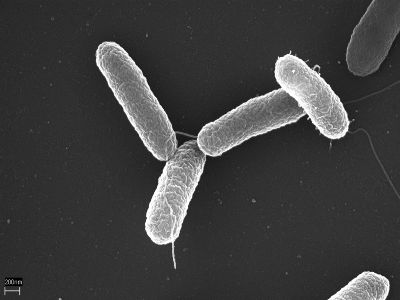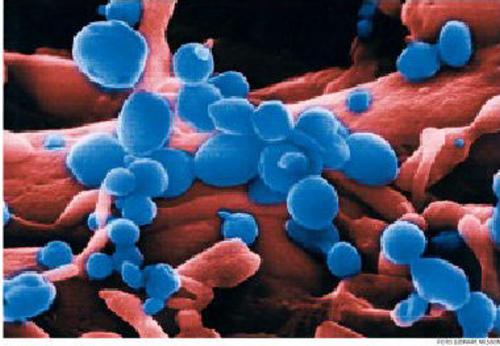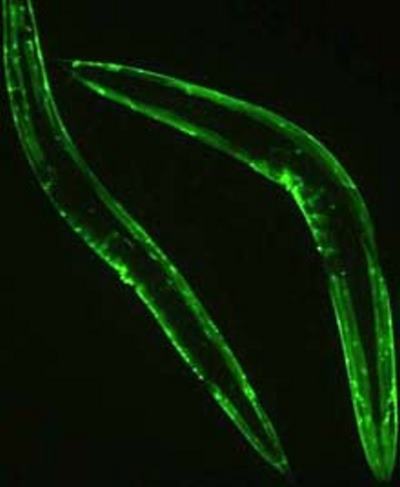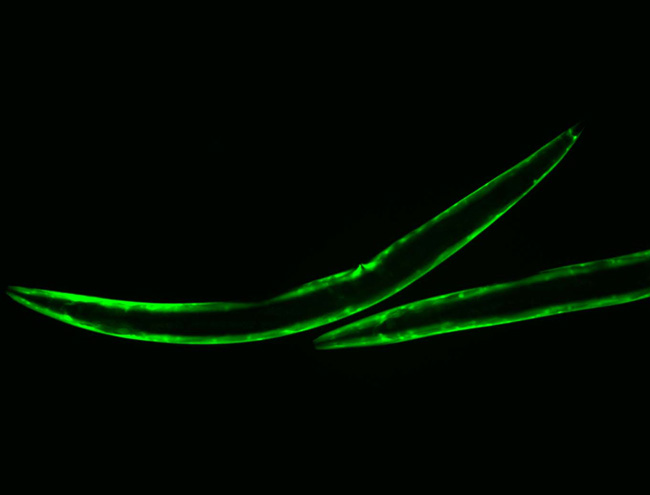|
Bacteria in Space |
|
|
..
Not Surprising: Radiated Microbes
Evolve In Space
News of a NASA experiment that exposed the bacteria salmonella to space flight aboard the shuttle Atlantis should not be a surprise. After days of exposure to the radiation of space, the microbes evolved into a more virulent and dangerous strain.. Some of us vividly recall problems the Russians had with runaway strains of mold aboard their 15-year old space station Mur. In the end the mold not only interfered with the electronics but began growing on metal, plastic and glass parts. The problem got so severe we believe it was one of the main reasons Mur was abandoned and allowed to crash into the ocean in 2001. It was our suspicion that the mold and fungus, as well as other microbes including germs, were being affected and altered by a constant bombardment of solar and other forms of radiation from outer space.. At first response, you might argue that radiation has been found to be an effective way of killing bacteria in food and water before it is packaged and sold in our stores, or delivered via our water taps. While a hearty dose of radiation indeed kills microbes, other forms of radiation, in smaller doses like the kind filtering into a moving space shuttle on the fringes of the Earth's atmosphere, may be zapping these tiny life forms just enough to cause them to evolve into stronger and more resistant strains suitable for space travel. The effect is much like the evolution of bacteria on
Earth after years of assault by a lineup of antibiotics. New and tougher
strains are emerging now that our existing battery of medicine cannot kill. This is truly a scary thought for all medical professionals, whether they are heart surgeons or Lasik eye surgery Houston experts. Even the possibility of bacteria getting inside a cornea during a Lasik procedure is enough for eye surgeons to take notice of this news. And when it comes to the possibility of extended space travel, the discovery that germs also evolve during exposure to radiation is significant. Of all the problems anticipated by NASA and other national space exploration teams in their quest to explore space and perhaps even send a manned mission to Mars, the evolution of a few billion germs and other microbes into a gang of deadly killer bugs was probably not expected. Consider that during a long trip to Mars, estimated to take at least nine months one-way, and nine-months back, the entire crew might be wiped out by a disease the evolves on the ship and strikes them in mid-flight. Solar and space radiation also is expected to affect the astronauts, but human evolution involves reproduction and generations of adaptation and change. Germs have a short life span but they reproduce rapidly. Thus change can occur within days if not hours. Humans cannot compete with that. In the Atlantis experiment, microbiologists at Arizona State University sent tubes with salmonella bacteria on a shuttle flight in September, 2006, to measure the effect space flight would have on a disease-causing microbe. They were shocked to discover that after a few days in orbit, the genetic pattern of the bacteria was changed. What returned was an even more virulent and dangerous form of salmonella. Writing in the journal Proceedings of the National Academy of Sciences, the professors who conducted the research, Cheryl Nickerson and James Wilson, said they discovered a regulatory protein Hfq appears to be responsible for the enhanced virulence of the bacteria after exposure to space. The study also found changes in the morphology of the bacteria, indicating the formation of a biofilm not found in the samples grown on Earth. Biofilms also may be linked to the increased strength of the exposed bacteria. SOURCE: Perdurabo10.tripod.com |
|
|
Andromeda Strain 2: NASA's Microbes-in-SpaceTest ..
Andromeda Strain 2: NASA's Microbes-in-SpaceTest
Once again, as is far too often the case, your campy B-movie’s have predicted a terrible future. First killer robots, then horrible things that climb out of swamps, and like a scene from Crichton's Andromeda Strain, killer germs from space Or, in reality, killer germs from earth, that have gone to space, and then come home again. That’s the news from a new report conducted by NASA on a shuttle mission from 2006. It was mission STS-115, back in September of 06, that NASA astronauts were accompanied on their spaceward journey by a batch of salmonella. Scientists wanted to see what effect the germs would take on after a space visit. What they found is somewhat disturbing, accompanied by how they found it. Man’s unwitting science partner – the lab mice – were fed the jetlagged salmonella, and were found to be three times more likely to get sick and die quicker than those mice who were fed the original salmonella. ''Wherever humans go, microbes go, you can't sterilize humans. Wherever we go, under the oceans or orbiting the earth, the microbes go with us, and it's important that we understand ... how they're going to change,'' said Cheryl Nickerson, associate professor at the Center for Infectious Diseases and Vaccinology at Arizona State University. This information doesn’t just affect the lab mice of the world, but also all those men and women who over the next several decades will be making manned missions to the International Space Station, the moon and Mars. For a long time, it has been common knowledge that extended space time can have a negative effect on bone density, muscle tone and the immune system. So why the adverse effect on germs? That’s the worrying part, no one’s really certain! ''We do not know,” said Nickerson, “with 100 percent certainty what the mechanism is of space flight that's inducing these changes.'' However, thankfully, there is at least a theory as to why this happens. ''Being cultured in microgravity means the force of the liquid passing over the cells is low,” said Nickerson, referring to the theorized “fluid shear” that they believe causes this change in cell structure. The salmonella cells ''are responding not to microgravity, but indirectly to microgravity in the low fluid shear effects.'' ''There are areas in the body which are low shear, such as the gastrointestinal tract, where, obviously, salmonella finds itself,'' she added. ''So, it's clear this is an environment not just relevant to space flight, but to conditions here on Earth, including in the infected host.'' ''These bugs can sense where they are by changes in their environment. The minute they sense a different environment, they change their genetic machinery so they can survive,'' she concluded. This news comes just two weeks after a British government advisory panel recommended that Britain disband their longstanding refusal to fund manned missions in to space, and recruit a four person team. I doubt that this will inspire any of the Brits to jump on board a manned mission to germ central. SOURCE: Daily Galaxy |
|
|
NASA Finds Unknown Extremophile Stowaways ..
C. elegans similar to these are at B.C.'s Simon Fraser University so researchers can study the effects of space radiation after dozens of generations reproduced at the International Space Station. NASA Finds Unknown Extremophile
Stowaways
NASA builds its spacecraft in specialized, sterilized rooms in an effort to minimize contamination by airborne particles. Dust, along with its microbial passengers, could potentially impair instruments and render experiments invalid. For example, if scientists do find microbes on Mars, they will want to be very certain that they aren’t looking at hitchhikers from Earth that were somehow able to survive the inter-solar ride. Gene sequencing is proving to be an effective means of detecting bacteria in these super-clean facilities as compared to previous monitoring methods. In fact, using the method, scientists not only found contaminants in the “sterilized” environment, but they even discovered a whole new species. NASA clean rooms, where scientists and engineers assemble spacecraft, have joined hot springs, ice caves, and deep mines as unlikely places where scientists have discovered ultra-hardy organisms collectively known as ‘extremophiles’. Some species of bacteria uncovered in a recent NASA study have never been detected anywhere else on the planet. According to Dr. Kasthuri Venkateswaran, who led the study conducted at NASA’s Jet Propulsion Laboratory in Pasadena, California, “These findings will advance the search for life on and other worlds both by sparking improved cleaning and sterilization methods and by preventing false-positive results in future experiments to detect .” Clean rooms used in the space program already undergo extensive cleaning and air filtering procedures, and the detection technology employed in this study will help NASA to develop and monitor improvements. Still, it is extremely difficult to eliminate all dust particles and microbes without damaging the electronic instruments the process is intended to protect. Identifying and archiving clean-room microbes could act as a sort of backup to cleaning and sterilization efforts. By comparing a list of microbes that could possibly stow away on its spacecraft, NASA can disregard them if they turn up in future Martian samples. Venkateswaran’s team used a technology known as ribosomal RNA gene-sequence analysis to detect the bacteria found in clean rooms at Kennedy Space Center, Johnson Space Center, and the Jet Propulsion Laboratory. This was the first time that this technology has been applied to NASA clean rooms. They found that both the total number of bacteria and the diversity of bacterial species were much higher than previously detected. This has implications not only for NASA and other space agencies, but also for hospital operating rooms and industries such as semiconductor manufacturing, where cleanliness and sterility are critical. Clean rooms are very extreme environments for microbes because water and nutrients are in extremely short supply. Nevertheless, some bacteria are able to survive on what little moisture the low-humidity air provides and on trace elements in wall paint, residue of cleaning solvents, and in the spacecraft materials, themselves. While not mentioned in the study, the possibility exists of accidentally contaminating the Martian surface with some of these extremophiles, especially as they are able to survive in incredibly harsh environments. If there are microbes living on Mars, a stowaway could potentially disrupt a delicate balance. On the other hand, if there are no living organisms on Mars—stowaways could theoretically change that. Posted by Rebecca Sato *This post was adapted from a news release issued by Blackwell Publishing. SOURCE: Daily Galaxy |
|
|
March 27, 2008 MEDIA ADVISORY : 08_21AR NASA Studies Microbes on Space Shuttle Flight Robin Croft
Moffett Field, Calif. - NASA launched four microbial experiments aboard the space shuttle Endeavour on March 11, 2008. NASA Ames Research Center's Fundamental Biology Research group is managing this flight project. The purpose of sending the microbes into space is to determine how they respond to spaceflight and whether their virulence or resistance to drugs is altered. The space-borne microbes are contained in special equipment developed by Bioserve Inc, of Boulder, Colo. The microorganisms are the focus of the work of four Ames-sponsored researchers: Cheryl Nickerson of the Biodesign Institute at Arizona State University in Tempe, Ariz.; Barry Pyle at Montana State University in Billings, Mont.; and two University of Texas Medical Branch researchers David Niesel and Michael McGinnis in Galveston,Texas. "Three of the four experiments were flown previously on the space shuttle. This flight offers the scientists an opportunity to confirm and build upon their previous results," said Kenneth A. Souza, manager of Fundamental Biology Research Projects at Ames. Nickerson's experiment focuses on Salmonella typhimurium, a leading cause of food-borne illness. Nickerson's previous study of Salmonella flew on the space shuttle Atlantis in 2006 and showed, for the first time, that spaceflight not only altered the bacterial gene expression, but also increased the ability of these organisms to cause disease in mice. In this experiment, the team will confirm their previous findings and determine if the modulation of different mineral concentrations may be used to counteract or block the spaceflight-associated increase in the disease-causing potential that was seen in Salmonella during Nickerson's first experiment. Niesel's experiment involves Streptococcus pneumonia, an "opportunistic bacterium" that's normally harmless, but can be a potent pathogen in infants, the elderly and people who have a weaker than normal immune system, including astronauts on long duration spaceflights. McGinnis is experimenting with the common yeast, Saccharomyces cerevisiae. This flight study will help answer the question of whether microgravity affects antifungal drug resistance in the yeast under actual spaceflight conditions. Pyle is studying Pseudomonas aeruginosa, a common water-borne bacterium that has been found in the space shuttle water system, thus posing a potential hazard to humans, especially during long-duration spaceflights. Information gained from these experiments is intended to provide insight into the molecular basis of microbial virulence and determine if microbial resistance to an antimicrobial agent is altered by spaceflight. The results from these studies may also help scientists develop strategies for the prevention and treatment of disease caused by these microbes, both on the ground and during spaceflight. “This mission enabled us to utilize the International Space Station and the space shuttle to increase our fundamental understanding of microbial adaptation to the space environment. With the information obtained, we hope to reduce the health risks to our crews during future exploration missions," said Carl Walz, director of the Applied Capabilities Division at NASA Headquarters' Exploration Systems Mission Directorate. SOURCE: NASA Press Release |
|
|
Space Worms Land in B.C., After Hopping Shuttle ..
C. elegans similar to these are at B.C.'s Simon Fraser University so researchers can study the effects of space radiation after dozens of generations reproduced at the International Space Station. Space Worms Land in B.C., After
Hopping Shuttle
Thousands of worms that hitched a ride to Earth on the shuttle Atlantis have arrived safely at a B.C. university, where they could shed light on how space radiation affects humans. The worms landed with the shuttle Friday afternoon at Edwards Air Force Base in California, six months after their ancestors — now long dead — were sent to the International Space Station. C. elegans similar to these are
at B.C.'s Simon Fraser University so researchers can study the effects
of space radiation after dozens of generations reproduced at the International
Space Station.C. elegans similar to these are at B.C.'s Simon Fraser University
so researchers can study the effects of space radiation after dozens of
generations reproduced at the International Space Station.
"The worms are at the lab and appear to be fine," molecular biologist Bob Johnsen told CBC News on Monday. The worms were sent to the space station to multiply rapidly, a special skill of the C. elegans worm, so Johnsen and his research team at Simon Fraser University in Burnaby could examine their descendants' genes for mutations. "We are looking for damage to DNA caused by space radiation," Johnsen told CBC News. The goal is to relate the information to potential effects on humans, who — from a scientific perspective — have a lot in common with the pencil-tip-sized wrigglers. "Both genomes have been sequenced and comparisons show that at least 50 per cent of genes are similar and therefore probably have similar functions. That includes DNA repair systems," said Johnsen. "The worms have the basics of higher organisms — muscle, gut, nervous system, skin, complex reproductive system. The worm is transparent and the entire cell lineage is known," he said. "We can take DNA from worms from space and run it against a chip [DNA microarray] to see if there is any damage." It will take several months before they can draw any conclusions. Each C. elegans worm lives only a week or two, but its offspring number in the hundreds. While worms and other creatures have made their homes on the International Space Station before, this is the longest duration and the first time many generations have developed in space. In 2003, C. elegans worms being used for other research were found intact in the wreckage of the Columbia space shuttle. The Simon Fraser researchers are among several groups
studying the worms. Some of the observers included students who watched
them during the six-month voyage using special cameras set up on the space
station.
SOURCE: CBC News |
|
|
Worms in Space! The ELERAD Experiment ..
(Credit: Simon Fraser University/Genome Canada/Genome BC/CSA) Worms in Space! The ELERAD Experiment
The scientific community's most popular worm is helping Canadian researchers document the radiation risks that astronauts will face on a trip to Mars. Scientists at Simon Fraser University (SFU) are studying genetic damage in worms that spent about seven months on the International Space Station in 2006 and 2007, producing between five and 10 generations of animals. The primary goal of this study was to validate new advanced technologies needed to do the complex analysis of how space radiation changes genes. In this "proof of principle" experiment, "a genome returned from space has been shown to have damage that we could define very precisely," said principle investigator David Baillie, Canadian Research Chair in genomics at SFU. One worm came back from space "with an extra piece of DNA inserted into the genetic material, carrying extra copies of eight different genes." The worms, known as C. elegans, were chosen because they're used extensively in medical research on Earth and the entire sequence of their genes is well known. About half their genome is similar to human genes, so the scientists believe the results of their study will be applicable to humans. The fact that the worms reproduce rapidly is significant because one goal of this research is to identify radiation damage to reproductive organs that can be passed on to offspring. Since genetic damage often kills organisms, the SFU scientists developed a new strain of the worms that allows them to keep damaged organisms alive so they can be studied. The SFU team is also testing a device called a DNA-array chip that enables them to identify genetic mutations quickly. For the first time, it was successfully used to detect DNA damage in a worm from space. "The chips have turned out to be more useful-and have worked better-than we thought," said Baillie. "We didn't know we could do this before we used the chips, but now we know they do work." Baillie also hopes to "resequence" the genes in the space worms-basically counting and studying every single one. Comparing this sequence with that of normal worms on Earth might uncover even more subtle changes. "We could look at genomes that didn't show obvious signs of genetic damage. A lot of the damage is actually silent -- you only see it when you sequence." The Canadian Space Agency funded this study because space radiation is a major obstacle to human spaceflight, said Luchino Cohen, a program scientist with CSA's space life sciences group. "It allows us to determine the effect of space radiation on a complete genome, which we really don't know yet. Once we know the impact of radiation on the whole genome, we can be better armed to develop countermeasures." However, to better understand the risks of a trip to
Mars, Baillie has to send his worms farther out than the Space Station,
which is protected from the worst space radiation by the Earth's magnetic
field. A high-flying satellite or an unmanned probe to the moon might provide
suitable platforms. "The goal is to get outside the magnetosphere because
that's where we expect the real damage to occur."
SOURCE: Canadian Space Agency |
|
|
Spaceworms jet off on Space Shuttle Atlantis Spaceworms jet off on Space Shuttle
Atlantis
The worms were on board when the Space Shuttle Atlantis was launched from Cape Canaveral on Monday The unexpected astronauts will help experts in human
physiology at the University of Nottingham understand more about what triggers
the body to build and lose muscle.
The Kibo lab makes use of the weightless conditions in orbit for the study of biomedicine and material sciences. The worms are used by Dr Nathaniel Szewczyk, from the university's Institute of Clinical Research in Derby, to study the signals that control muscle protein degradation. He uses the microscopic worm Caenorhabditis elegans (C. elegans), because they are the perfect substitute for studying long term changes in human physiology – suffering from muscle loss under many of the same conditions that people do. Muscle loss, or muscle atrophy, is one of the major health concerns for astronauts. The research is also hoped to help scientists understand more about the condition which also affects the bedridden, people with muscular dystrophy and diabetes, people immobilised by casts and the elderly. The worms, traced back to a rubbish dump in Bristol, often feed on bacteria that develop on decaying vegetable matter. Their predecessors made news in 2003 when they survived the Space Shuttle Columbia disaster, including re-entry and impact, and were recovered weeks after the disaster. Dr Szewczyk, who has carried out three previous space worm missions, is working with Professor Atsushi Higashitani from Tohoku University, Sendai, Japan. Professor Higashitani is the Principal Investigator of the CERISE (C. Elegans RNAi In Space Experiment) payload and will be based in Florida during the flight to co-ordinate the payload's experiments. Dr Szewczyk said: ''We can learn things in space that we would not be able to learn on earth. ''If we can identify what causes the body to react in certain ways in space we establish new pathways for research back on earth.'' C. elegans was the first multicellular organism to have its genetic structure completely mapped and many of its 20,000 genes perform the same functions as those in humans. Dr Szewczyk's researcher Dr Tim Etheridge has been given the task of preparing the worms for their journey to the International Space Station, roughly 200 miles from the Earth. They have been carefully selected and brought to a dormant state for the journey, travelling in special cell culture bags. They will be brought back from their dormant state with the release of food, exposed to conditions in space for four days and then frozen in preparation for the return journey. The effect of this journey on their muscle mass will be investigated once the worms are returned to the university's laboratories in Derby. Dr Szewczyk said: ''The CERISE payload is an important space medicine experiment as it will establish if RNAi, which was the subject of the 2006 Nobel Prize in Medicine, is a viable technique for altering the biological response to space flight. ''For example, some of our worms will be treated with RNAi against specific proteases to see if we can stop muscle protein degradation in space.'' The worms will be on board Space Shuttle Atlantis when it takes off from the Kennedy Space Centre today at 2.28pm local time (7.28pm GMT). Both Dr Szewczyk and Dr Etheridge have travelled to Florida to see the worms safely on-board the space shuttle. SOURCE: The Telegraph |
|
| FAIR USE NOTICE: This page contains copyrighted material the use of which has not been specifically authorized by the copyright owner. Pegasus Research Consortium distributes this material without profit to those who have expressed a prior interest in receiving the included information for research and educational purposes. We believe this constitutes a fair use of any such copyrighted material as provided for in 17 U.S.C § 107. If you wish to use copyrighted material from this site for purposes of your own that go beyond fair use, you must obtain permission from the copyright owner. | |
|
|





